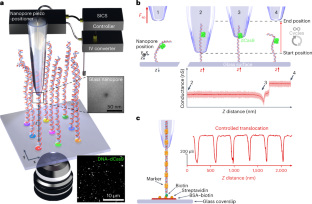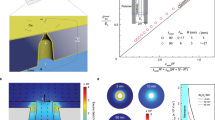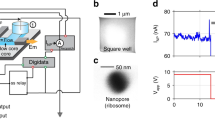Abstract
In current nanopore-based label-free single-molecule sensing technologies, stochastic processes influence the selection of translocating molecule, translocation rate and translocation velocity. As a result, single-molecule translocations are challenging to control both spatially and temporally. Here we present a method using a glass nanopore mounted on a three-dimensional nanopositioner to spatially select molecules, deterministically tethered on a glass surface, for controlled translocations. By controlling the distance between the nanopore and glass surface, we can actively select the region of interest on the molecule and scan it a controlled number of times and at a controlled velocity. Decreasing the velocity and averaging thousands of consecutive readings of the same molecule increases the signal-to-noise ratio by two orders of magnitude compared with free translocations. We demonstrate the method’s versatility by assessing DNA–protein complexes, DNA rulers and DNA gaps, achieving down to single-nucleotide gap detection.
This is a preview of subscription content, access via your institution
Access options
Access Nature and 54 other Nature Portfolio journals
Get Nature+, our best-value online-access subscription
$29.99 / 30 days
cancel any time
Subscribe to this journal
Receive 12 print issues and online access
$259.00 per year
only $21.58 per issue
Buy this article
- Purchase on Springer Link
- Instant access to full article PDF
Prices may be subject to local taxes which are calculated during checkout




Similar content being viewed by others
Data availability
The data that support the plots in Figs. 1b,c, 2b–g, 3c–e and 4b,d are available via Zenodo at https://doi.org/10.5281/zenodo.7834215. Source data are provided with this paper.
References
Branton, D. et al. The potential and challenges of nanopore sequencing. Nat. Biotechnol. 26, 1146–1153 (2008).
Schneider, G. F. & Dekker, C. DNA sequencing with nanopores. Nat. Biotechnol. 30, 326–328 (2012).
Brinkerhoff, H., Kang, A. S. W., Liu, J., Aksimentiev, A. & Dekker, C. Multiple rereads of single proteins at single-amino acid resolution using nanopores. Science 374, 1509–1513 (2021).
Manrao, E. A. et al. Reading DNA at single-nucleotide resolution with a mutant MspA nanopore and phi29 DNA polymerase. Nat. Biotechnol. 30, 349–353 (2012).
Derrington, I. M. et al. Subangstrom single-molecule measurements of motor proteins using a nanopore. Nat. Biotechnol. 33, 1073–1075 (2015).
Fragasso, A., Schmid, S. & Dekker, C. Comparing current noise in biological and solid-state nanopores. ACS Nano 14, 1338–1349 (2020).
Li, J. et al. Ion-beam sculpting at nanometre length scales. Nature 412, 166–169 (2001).
Storm, A., Chen, J., Ling, X., Zandbergen, H. & Dekker, C. Fabrication of solid-state nanopores with single-nanometre precision. Nat. Mater. 2, 537–540 (2003).
Dekker, C. Solid-state nanopores. Nanoscience and Technology: A Collection of Reviews from Nature Journals 60–66 (2010).
Garaj, S. et al. Graphene as a subnanometre trans-electrode membrane. Nature 467, 190–193 (2010).
Xue, L. et al. Solid-state nanopore sensors. Nat. Rev. Mater. 5, 931–951 (2020).
Yusko, E. C. et al. Real-time shape approximation and fingerprinting of single proteins using a nanopore. Nat. Nanotechnol. 12, 360–367 (2017).
Lu, B., Albertorio, F., Hoogerheide, D. P. & Golovchenko, J. A. Origins and consequences of velocity fluctuations during DNA passage through a nanopore. Biophys. J. 101, 70–79 (2011).
Plesa, C., Van Loo, N., Ketterer, P., Dietz, H. & Dekker, C. Velocity of DNA during translocation through a solid-state nanopore. Nano Lett. 15, 732–737 (2015).
Rosenstein, J. K., Wanunu, M., Merchant, C. A., Drndic, M. & Shepard, K. L. Integrated nanopore sensing platform with sub-microsecond temporal resolution. Nat. Methods 9, 487–492 (2012).
Steinbock, L. J., Otto, O., Chimerel, C., Gornall, J. & Keyser, U. F. Detecting DNA folding with nanocapillaries. Nano Lett. 10, 2493–2497 (2010).
Bell, N. A. W., Chen, K., Ghosal, S., Ricci, M. & Keyser, U. F. Asymmetric dynamics of DNA entering and exiting a strongly confining nanopore. Nat. Commun. 8, 380 (2017).
Steinbock, L. J., Bulushev, R. D., Krishnan, S., Raillon, C. & Radenovic, A. DNA translocation through low-noise glass nanopores. ACS Nano 7, 11255–11262 (2013).
Aramesh, M. et al. Localized detection of ions and biomolecules with a force-controlled scanning nanopore microscope. Nat. Nanotechnol. 14, 791–798 (2019).
Yuan, Z., Liu, Y., Dai, M., Yi, X. & Wang, C. Controlling DNA translocation through solid-state nanopores. Nanoscale Res. Lett. 15, 80 (2020).
Rahman, M., Sampad, M. J. N., Hawkins, A. & Schmidt, H. Recent advances in integrated solid-state nanopore sensors. Lab Chip 21, 3030–3052 (2021).
Hansma, P. K., Drake, B., Marti, O., Gould, S. A. & Prater, C. B. The scanning ion-conductance microscope. Science 243, 641–643 (1989).
Korchev, Y. E., Bashford, C. L., Milovanovic, M., Vodyanoy, I. & Lab, M. J. Scanning ion conductance microscopy of living cells. Biophys. J. 73, 653–658 (1997).
Novak, P. et al. Nanoscale live-cell imaging using hopping probe ion conductance microscopy. Nat. Methods 6, 279–281 (2009).
Leitao, S. M. et al. Time-resolved scanning ion conductance microscopy for three-dimensional tracking of nanoscale cell surface dynamics. ACS Nano 15, 17613–17622 (2021).
Navikas, V. et al. High-throughput nanocapillary filling enabled by microwave radiation for scanning ion conductance microscopy imaging. ACS Appl. Nano Mater. 3, 7829–7834 (2020).
Rief, M., Oesterhelt, F., Heymann, B. & Gaub, H. E. Single molecule force spectroscopy on polysaccharides by atomic force microscopy. Science 275, 1295–1297 (1997).
Chen, K. et al. Dynamics of driven polymer transport through a nanopore. Nat. Phys. 17, 1043–1049 (2021).
Chen, K. et al. Digital data storage using DNA nanostructures and solid-state nanopores. Nano Lett. 19, 1210–1215 (2018).
Tabatabaei, S. K. et al. DNA punch cards for storing data on native DNA sequences via enzymatic nicking. Nat. Commun. 11, 1742 (2020).
Clegg, R. M. Fluorescence resonance energy transfer and nucleic acids. Methods Enzymol. 211, 353–388 (1992).
Lelek, M. et al. Single-molecule localization microscopy. Nat. Rev. Methods Primers 1, 39 (2021).
Jungmann, R. et al. Single-molecule kinetics and super-resolution microscopy by fluorescence imaging of transient binding on DNA origami. Nano Lett. 10, 4756–4761 (2010).
Zhu, C. et al. Imaging with ion channels. Anal. Chem. 93, 5355–5359 (2021).
Radmacher, M., Cleveland, J. P., Fritz, M., Hansma, H. G. & Hansma, P. K. Mapping interaction forces with the atomic force microscope. Biophys. J. 66, 2159–2165 (1994).
Schindelin, J. et al. Fiji: an open-source platform for biological-image analysis. Nat. Methods 9, 676–682 (2012).
Nečas, D. & Klapetek, P. Gwyddion: an open-source software for SPM data analysis. Open Phys. 10, 181–188 (2012).
Wang, H. & Hays, J. B. Simple and rapid preparation of gapped plasmid DNA for incorporation of oligomers containing specific DNA lesions. Mol. Biotechnol. 19, 133–140 (2001).
Jozwiakowski, S. K. & Connolly, B. A. Plasmid-based lacZα assay for DNA polymerase fidelity: application to archaeal family-B DNA polymerase. Nucleic Acids Res. 37, e102 (2009).
Auburn, R. P. et al. Robotic spotting of cDNA and oligonucleotide microarrays. Trends Biotechnol. 23, 374–379 (2005).
Navikas, V. et al. Correlative 3D microscopy of single cells using super-resolution and scanning ion-conductance microscopy. Nat. Commun. 12, 4565 (2021).
Acknowledgements
S.M.L. and G.E.F. acknowledge support from the Swiss Commission for Technology and Innovation under grant CTI-18330.1, and the European Research Council under grant no. ERC-2017-CoG, InCell. V.N., H.M. and A.R. acknowledge support from the National Center of Competence in Research (NCCR) Bio-Inspired Materials and Max-Planck-EPFL Center of Molecular Nanoscience and Technology. K.C. and U.F.K. were funded by PoreDetect (ERC-2019-POC, 899538) and EarlyPore (ERC-2022-POC1, 101069324).
Author information
Authors and Affiliations
Contributions
S.M.L. developed the SICS system and performed the SICS measurements. S.M.L. and V.N. performed the data analysis with support from S.M. V.N. and H.M. prepared the single-molecule samples and fabricated the nanocapillaries. G.P.B. and A.K. created the DNA gap molecules. H.M. and S.F.M. created the oligonucleotides–DNA gap templates. K.C. and U.F.K. created the DNA rulers and provided free translocation data. S.M.L. and B.D. built the original SICM setup used in this work. A.R., G.E.F., S.M.L. and V.N. designed the experiments with input from all the authors. A.R. conceived the method. G.E.F. and A.R. supervised the project. S.M.L., G.E.F. and A.R. wrote the manuscript with input from all the authors.
Corresponding authors
Ethics declarations
Competing interests
A.R., G.E.F., S.M.L. and V.N. filed a patent application PCT/IB2022/055136 titled ‘Nanopore-based scanning system and method’, Switzerland.
Peer review
Peer review information
Nature Nanotechnology thanks Paolo Actis, Manoj Varma and the other, anonymous, reviewer(s) for their contribution to the peer review of this work.
Additional information
Publisher’s note Springer Nature remains neutral with regard to jurisdictional claims in published maps and institutional affiliations.
Supplementary information
Supplementary Information
Supplementary Figs. 1–16.
Source data
Source Data Fig. 1b
Source data containing the conductance signal as a function of distance for Fig. 1b.
Source Data Figs. 1c and 2b
Source data containing the conductance signal as a function of distance for Figs. 1c and 2b.
Source Data Fig. 2c
Source data containing the conductance signal as a function of distance for four different velocities for Fig. 2c.
Source Data Fig. 2d
SNR values for the detection of markers at different translocation velocities.
Source Data Fig. 2e
Values of amplitude and distance of the ruler’s markers in free translocations and controlled translocations.
Source Data Fig. 2f
Source data containing the conductance signal as a function of distance for Fig. 2f.
Source Data Fig. 2g
Source data containing the conductance signal as a function of distance for Fig. 2g.
Source Data Fig. 3c
Source data containing the conductance signal as a function of distance for Fig. 3c.
Source Data Fig. 3d
Source data containing the conductance values at a corresponding distance used to plot the density map in Fig. 3d.
Source Data Fig. 3e
Source data containing the conductance values at a corresponding distance used to plot the density map in Fig. 3e.
Source Data Fig. 4b top
Source data containing the conductance values at a corresponding distance used to plot the density map in Fig. 4b (top).
Source Data Fig. 4b bottom
Source data containing the conductance values at a corresponding distance used to plot the density map in Fig. 4b (bottom).
Source Data Fig. 4d
Source data containing the conductance values at a corresponding distance used to plot the density map in Fig. 4d.
Rights and permissions
Springer Nature or its licensor (e.g. a society or other partner) holds exclusive rights to this article under a publishing agreement with the author(s) or other rightsholder(s); author self-archiving of the accepted manuscript version of this article is solely governed by the terms of such publishing agreement and applicable law.
About this article
Cite this article
Leitao, S.M., Navikas, V., Miljkovic, H. et al. Spatially multiplexed single-molecule translocations through a nanopore at controlled speeds. Nat. Nanotechnol. 18, 1078–1084 (2023). https://doi.org/10.1038/s41565-023-01412-4
Received:
Accepted:
Published:
Issue Date:
DOI: https://doi.org/10.1038/s41565-023-01412-4
This article is cited by
-
Controlling translocations
Nature Reviews Materials (2023)
-
An external speed control for nanopore reads
Nature Nanotechnology (2023)



